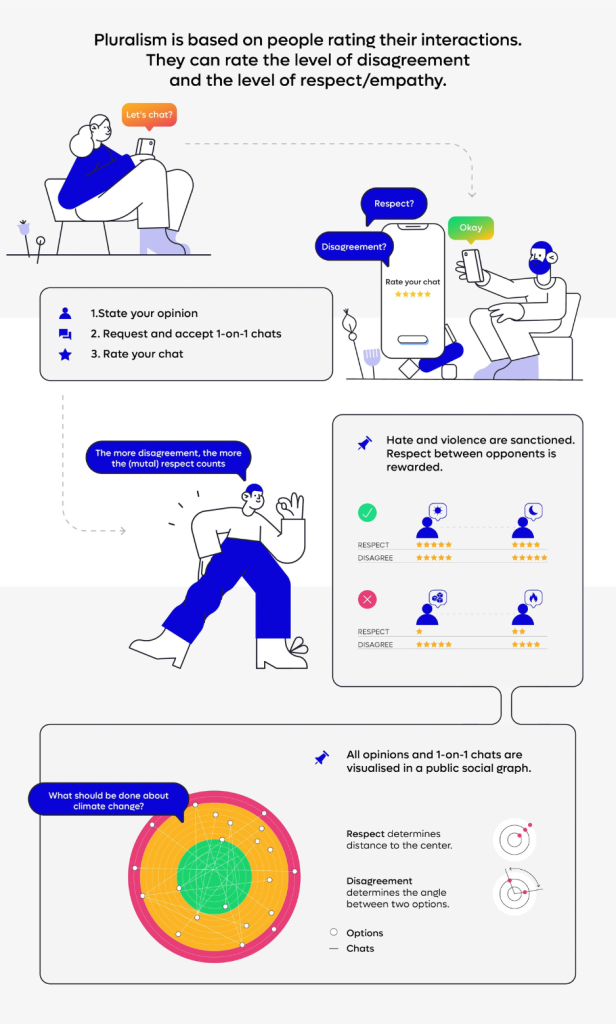Democracy Technologies: You started out in print media. Why did you turn your attention to social media? What do you think needs to change?
Iwan Ittermann: Social media was a lot of fun to start with. But as soon as the profiles went public, and people began interacting with people they didn’t know personally, there was a real shift. Initially, if someone received a friend request from someone they didn’t know, they got annoyed. But then suddenly, friends were replaced with followers. If you go back to that moment in time when Facebook changed that term, that’s the point where things got really exciting – but it’s also the point at which our collective sugar levels got dangerously high. And then we got diabetes as a society.
2014 was the point where I personally started to find social media a lot less attractive. If you look at user retention, you’ll see that this fits with a wider trend. For me, it started with the invasion of the Crimean Peninsula. It was the first time I realised that having two completely different opinions based on alternative facts is simply not a good thing for public discourse. It became clear to me that there needs to be some kind of dialogue, rather than just everyone posting contrasting messages, and choosing which “truth” to believe.
The basic idea behind my first project at Digital Peace Talks was that opinions should be legitimised through dialogues with opposing opinions. In other words: you’re still free to think and say whatever you like. But if you want other people to pay attention to it, the degree of attention it receives shouldn’t just be based on likes. Instead, it should be based on how well you interact with people with opposing views. Instead of just being applauded by people who hold the same beliefs as you, you should talk to the people who see things differently.
DT: Why do you think it’s important to focus on dialogue?
Ittermann: If we fast forward a bit, I think it’s clear that we can distinguish between content and conversations. Content can be judged according to >journalistic standards. The world is getting better and better at recognising: this might be a conspiracy theory, or this looks well-founded. Bias still plays a role here, of course.
But then there is the realm of opinion. And these are two different things. If we look at TikTok or Instagram, we can see that social media concentrates on content, while the interactive part is buried away. These formats are thriving – whereas social networks based on interactions, such as X and Threads, are having a very difficult time. They treat conversations like content, but their engagement-optimised models give no incentives for users to interact with each other in a respectful way. They are designed in a way that makes content moderation necessary. But the cost advantage is always on the side of the attackers.
DT: Tell us about your current project, Pluralism
Ittermann: The key idea behind Pluralism is to create a way of rewarding respectful disagreement. Most existing ranking systems tend to reward provocation or content that creates strong emotional responses. This actually promotes hateful interactions. Unlike existing ranking mechanisms, Pluralism promotes respectful dialogue between people with different views.
The process begins with participants posting an opinion about a specific topic set by the host organisation – for example, “What should be done about climate change?” They are then invited to engage in a dialogue with someone with views different to their own. Following the exchange, each user rates the conversation, giving it one score for the level of disagreement, and another for the level of respect.
The key point is that these two scores, disagreement and respect, are multiplied. In other words: the more disagreement between two people, the more the respect counts.
In the final stage, all of these opinions and their interactions are visualised in a form of publicly accessible social graph (see the diagram below). Each opinion is visualised as a point on a circle. Lines connecting the points to one another represent conversations. Let’s say you have a conversation which is scored ten out of ten points for disagreement. On the circle, the algorithm would try to place them at diametrically opposed points, at an angle of 180 degrees.
But here comes the trick: An opinion’s distance from the centre of the circle is determined by the “respect” score. If the conversation is rated by both participants as very respectful, it will be near the centre of the circle. If it is disrespectful, the points are pushed to the outer fringes.
This means that being disrespectful to opposing views is sanctioned, instead of being promoted. That’s the key difference from existing social networks. Since it is a community governed tool, it would be possible for the community to decide if there should be some kind of cutoff point, so that highly disrespectful interactions lead to comments being deleted. But that is something the community using the tool could decide for themselves.
DT: What stage is Pluralism at?
Ittermann: I have been working on this idea for over 7 years now. The first version of Pluralism was launched in 2020 under the name “Digital Peace Talks.” It was a functional platform that enabled discussions in a 3-dimensional space through a graph layout. But the graph layout was static, no function to sort or rank was applied. The key development came in 2021, when we decided the two main operators should be respect and disagreement.
In 2022 we launched a live demo of the ranking algorithm called “Polarizer”. The demo used real opinions from Facebook, which were fed into a simulated, imaginary conversation. We then created a mockup of the social graph.
I am currently talking to newspaper outlets to conduct a field test with 200 randomly selected participants that discuss a topic jointly formulated together with representatives of marginalised groups. The media outlet would analyse the data and stories and report on the outcomes of the respectful discussion.
The newest version is not itself a platform. Instead, it takes posts from existing communication technology like WhatsApp, X, Reddit, LinkedIn and provides the social graph as a visualisation layer on top of it. This means that existing social media functions as the starting point for the conversation, and Pluralism provides an alternative way of curating it.
DT: What do you hope the future of social media should look like?
Ittermann: I think we will look back on this era and be repelled by the amount of engagement we have with our devices. From where we stand today, it’s hard to imagine what a natural, healthy media consumption would look like. But let’s say, maybe once a day or once a week, you would express your democratic right and take part in public discourse. Partly out of a sense of obligation, but also as a way of addressing things you are concerned about. People want to exchange with one another, and it doesn’t always have to be political, of course.
Pluralism could be used to help us as a society to bridge our differences or overcome them. It forces people to move beyond the old way of simply judging someone else’s position and coming up with counterarguments. It focuses on the beauty of engaged dialogue and real human connections.

